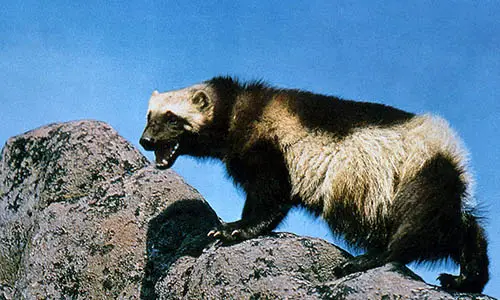The Wolverine was called the Bear Skunk by the Blackfeet Indians. Though the wolverine looks like a bear, it is not a member of the bear family. It belongs to the family Mustelidae, the weasel family. The wolverine is the largest member of the Mustelidae. They live in rugged remote country along or above the tree line. Wolverines are rarely seen. Small black bears, darker coloured red foxes and American badgers are of misidentified as wolverines. Given the harsh habitat they live in their population density is naturally low.
FACT 1: Male wolverines are 30 to 40 % larger than females. They can weigh between 10 and 30 kilos and are 65 to 110cm long. In the wild they live between 5 and 13 years. They have a bushy tail, about 25cm long. Each individual has unique colouration pattern on the face neck and chest. This makes it easy for researchers to identify the individual wolverine.
FACT 2: Wolverines are great roamers. They roam through the remote sub-Arctic regions of the tundra and taiga in North America and Eurasia. Near Yellowstone, USA, researchers tracked an adult male wolverine as he travelled more than 500 miles in 42 days
FACT 3: They are solitary animals. The males mark out and defend their territory. A number of females may live within this territory. Females give birth in winter they tunnel through the snow to make their dens. The baby wolverines are called kits and are blind and pure white when they are born. A female gives birth to one or two kits at a time, though a litter could have up to 5 kits. The den protects the kits from predators and keeps them warm in the sub- zero temperatures. Wolverines maintain family ties. Kits may live with their mother for up to 2 years and males continue to socialize with their kits even after the kits attain maturity.
FACT 4: Wolverines are not fussy eaters. They enjoy a hearty vegetarian meal of plants and berries, but they are omnivores. Meat is an essential component of their diet. They prey mostly on smaller animals like rodents and rabbits. However they are tough predators and if they spot a weak or injured animal they can bring it down, even if it is much larger than they are. When push comes to shove and the winter dearth of prey sets in they will lower their standards and enthusiastically feed on the carrion of large mammals like the elk, the caribou and deer.
FACT 5: Like the Polar Bear the wolverine is well adapted to thrive in freezing temperatures. Their thick fur keeps them warm and their paws work like snow shoes. They do not sink into deep snow. Their claws are the perfect tools for climbing over steep cliffs and over snowy peaks. The wolverine does not need to hibernate in winter. It is their time for childbirth and will in fact dig into the burrow of a hibernating mammal, if a snack is urgently needed.
FACT 6: Most carnivores do not have the jaw power to crunch up the bones of their prey. The wolverine’s powerful jaws and teeth can break up and eat both meat and bones, either fresh or frozen.
FACT 7: A unique feature of wolverine reproduction is the embryonic diapause. The embryo does not get implanted as soon as fertilization takes place. It remains in a state of dormancy until conditions are suitable for pregnancy and nursing.
FACT 8: There are not many wolverines in captivity. Worldwide the number is about 80. They do not breed easily in captivity. In 2012, Sarka and Sharpova, at the Cotswold Wildlife Park in UK became the proud parents of triplets, Sunshine, Liv and Gutt.
FACT 9: As with all animals that have been unfortunate enough to possess beautiful thick fur coats, the wolverine has been widely hunted for its fur. The fur was used to line parkas. At present there are less than 300 wolverines in the United States.
FACT 10: Though the International Union for Conservation of Nature (IUCN) has placed the wolverine on the Least Concern List, their population of this beautiful rugged animal of the rugged Northern habitats, is on the decline











Leave a Reply